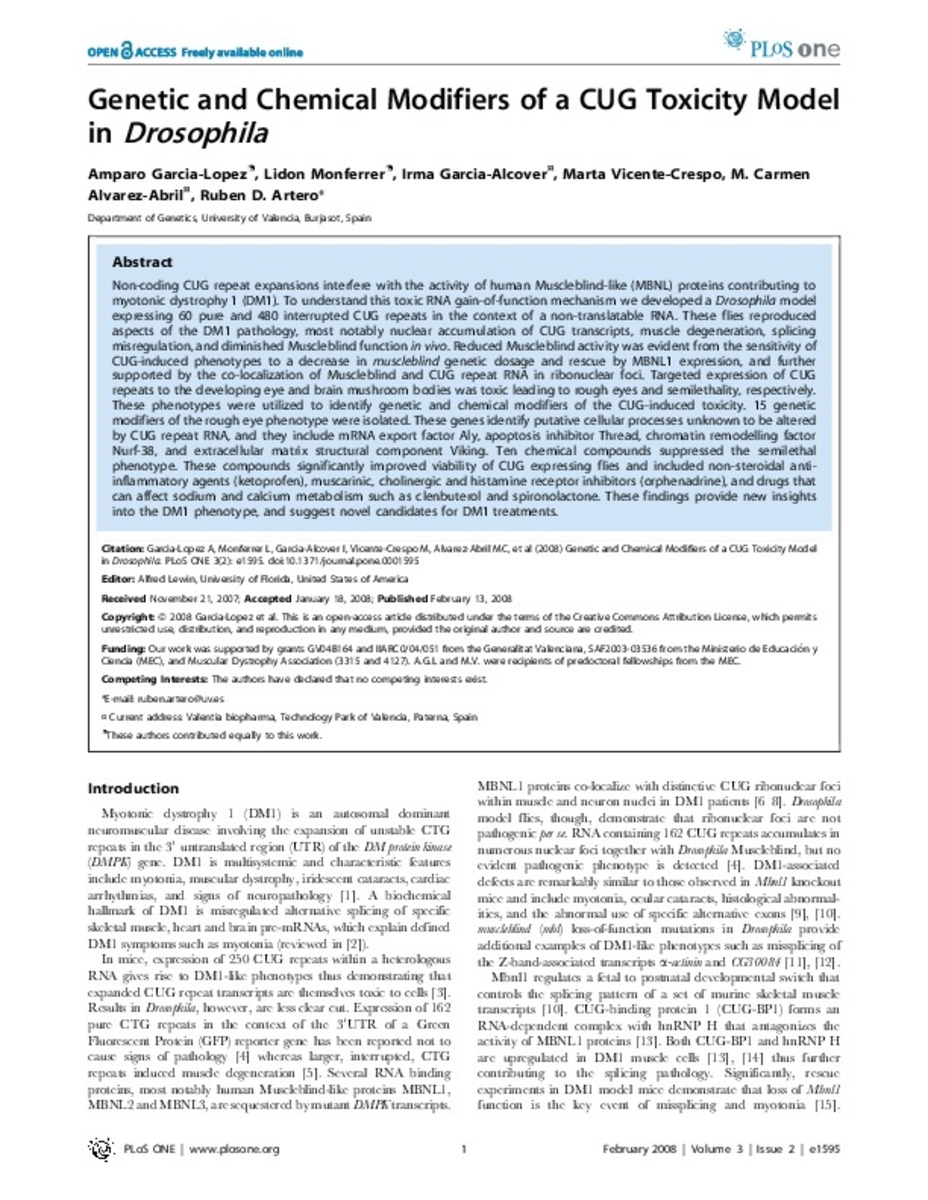Mostrar el registro sencillo del ítem
Genetic and Chemical Modifiers Of A CUG Toxicity Model in Drosophila
| dc.contributor.author | Artero, Ruben D. | |
| dc.contributor.author | Álvarez Abril, María Carmen | |
| dc.contributor.author | Vicente Crespo, Marta | |
| dc.contributor.author | García Alcover, Irma | |
| dc.contributor.author | García López, Amparo | |
| dc.contributor.author | Monferrer Sales, Lidón | |
| dc.date.accessioned | 2010-05-10T12:05:40Z | |
| dc.date.available | 2010-05-10T12:05:40Z | |
| dc.date.issued | 2008 | |
| dc.identifier.issn | 1932-6203 | |
| dc.identifier.uri | http://hdl.handle.net/10234/12562 | |
| dc.description.abstract | Non-coding CUG repeat expansions interfere with the activity of human Muscleblind-like (MBNL) proteins contributing to myotonic dystrophy 1 (DM1). To understand this toxic RNA gain-of-function mechanism we developed a Drosophila model expressing 60 pure and 480 interrupted CUG repeats in the context of a non-translatable RNA. These flies reproduced aspects of the DM1 pathology, most notably nuclear accumulation of CUG transcripts, muscle degeneration, splicing misregulation, and diminished Muscleblind function in vivo. Reduced Muscleblind activity was evident from the sensitivity of CUG-induced phenotypes to a decrease in muscleblind genetic dosage and rescue by MBNL1 expression, and further supported by the co-localization of Muscleblind and CUG repeat RNA in ribonuclear foci. Targeted expression of CUG repeats to the developing eye and brain mushroom bodies was toxic leading to rough eyes and semilethality, respectively. These phenotypes were utilized to identify genetic and chemical modifiers of the CUG-induced toxicity. 15 genetic modifiers of the rough eye phenotype were isolated. These genes identify putative cellular processes unknown to be altered by CUG repeat RNA, and they include mRNA export factor Aly, apoptosis inhibitor Thread, chromatin remodelling factor Nurf-38, and extracellular matrix structural component Viking. Ten chemical compounds suppressed the semilethal phenotype. These compounds significantly improved viability of CUG expressing flies and included non-steroidal antiinflammatory agents (ketoprofen), muscarinic, cholinergic and histamine receptor inhibitors (orphenadrine), and drugs that can affect sodium and calcium metabolism such as clenbuterol and spironolactone. These findings provide new insights into the DM1 phenotype, and suggest novel candidates for DM1 treatments | en |
| dc.format.extent | 5 p. | |
| dc.language.iso | eng | en |
| dc.publisher | Public Library of Science (PLoS) | en |
| dc.relation.isPartOfSeries | PLoS one; vol. 3 núm. 2 | |
| dc.rights.uri | http://rightsstatements.org/vocab/CNE/1.0/ | * |
| dc.subject.other | Genètica | |
| dc.title | Genetic and Chemical Modifiers Of A CUG Toxicity Model in Drosophila | en |
| dc.type | info:eu-repo/semantics/article | en |
| dc.rights.accessRights | info:eu-repo/semantics/openAccess | |
| dc.type.version | info:eu-repo/semantics/acceptedVersion | ca_CA |
Ficheros en el ítem
Este ítem aparece en la(s) siguiente(s) colección(ones)
-
PSB_Articles [1293]
Articles de publicacions periòdiques







